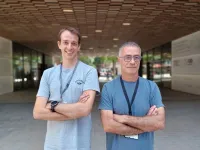(Press-News.org)
The ozone layer, a crucial shield protecting life on Earth from harmful ultraviolet (UV) radiation, has been on a path to recovery thanks to the Montreal Protocol. This landmark international treaty, adopted in 1987, successfully led to phasing out the production of numerous substances responsible for ozone depletion. Over the past decades, the ozone layer has shown significant signs of healing, a testament to global cooperation and environmental policy.
However, the stability of this vital atmospheric layer is now facing a new and unexpected challenge. During the 2019/20 Australian wildfires, researchers observed a dramatic increase in stratospheric aerosols – tiny particles that can influence climate, health, and atmospheric chemistry.
Smoke-charged vortex transports aerosol up to 35 kilometers
Utilizing new satellite data and numerical modeling, the research team successfully demonstrated the impact of wildfires through a novel phenomenon: the smoke-charged vortex (SCV).
“The SCV is a powerful, smoke-laden whirlpool that transports wildfire smoke into the middle stratosphere, reaching altitudes of up to 35 kilometers,” explained Prof. Hang Su from the Institute of Atmospheric Physics at the Chinese Academy of Sciences, one of the corresponding authors of the study. “This process led to at least a doubling of the aerosol burden in the southern hemisphere’s middle stratosphere. Once reaching such high altitudes, these aerosols initiated a series of chemical reactions at their surface that impacted ozone concentrations.”
The international team discovered that these wildfire-induced aerosols facilitated heterogeneous chemical reactions in the stratosphere, which paradoxically led to both ozone depletion and ozone increase at different atmospheric layers.
While the lower stratosphere experienced significant ozone depletion, the new study shows that the increase of smoke aerosol particles in the middle stratosphere enhances the heterogeneous uptake and hydrolysis of N2O5, which leads to a decrease of reactive nitrogen gases, e.g., NOx, and an increase of ozone. In Southern Mid-Latitudes, the complex interplay managed to buffer approximately 40% (up to 70%) of the ozone depletion observed in the lower stratosphere in the following months of the mega-bushfire events.
So why does this matter?
“Our study uncovers an unexpected and crucial mechanism by which the absorbing aerosols in wildfire smoke, such as black carbon, can induce and sustain enormous smoke-charged vortices spanning thousands of kilometers, fundamentally changing the stratospheric circulation. The vortices can persist for months, carrying aerosols deeply into the stratosphere and affecting the ozone layer in distinct ways at different altitudes. This highlights the need for continued vigilance and research as climate change progresses,” said Prof. Yafang Cheng, another leading author from the Max Planck Institute for Chemistry.
“We’ve made a significant step forward in simulating the SCV as a new effective pathway for wildfires to modify stratospheric dynamics and chemistry, especially the ozone layer. I love this study because it once again demonstrates how closely different parts of the Earth system are connected. Smoke from a forest fire can significantly change the wind and circulation tens of kilometers above the ground, which allows the smoke to modify the ozone layer, influencing life on our planet,” said Dr. Chaoqun Ma, the first author of the study and postdoc researcher in Cheng’s team at the MPIC.
The ozone layer’s role in filtering UV radiation is crucial for protecting all life forms on Earth. The Montreal Protocol’s success in reducing ozone-depleting substances was a monumental achievement. Still, the new findings highlight that natural events, exacerbated by climate change, pose additional risks to this fragile atmospheric layer. With the increasing frequency and intensity of wildfires driven by global warming, the formation of SCVs and their impact on the stratosphere could become more common, posing a threat to the ozone layer.
END
Stories written with AI assistance have been deemed to be more creative, better written and more enjoyable.
A new study published in the journal Science Advances finds that AI enhances creativity by boosting the novelty of story ideas as well as the ‘usefulness’ of stories – their ability to engage the target audience and potential for publication.
It finds that AI “professionalizes” stories, making them more enjoyable, more likely to have plot twists, better written and less boring.
In ...
Researchers at the Texas A&M School of Veterinary Medicine and Biomedical Sciences (VMBS) have uncovered how natural selection “rewilds” domestic rabbits.
The study, published in Nature Ecology and Evolution, helps answer the question of how normally tame rabbits — which have many natural predators — can become a force of ecological destruction when purposefully or accidentally reintroduced to the wild.
Here Comes Peter Cottontail
Every gardener knows how much of a nuisance rabbits can be, but ...
By Leah Shaffer
You can think of our atmosphere as a big chemistry set, a global churn of gaseous molecules and particles that constantly bounce off and change each other in complicated ways. While the particles are very small, often less than 1% of the thickness of human hair, they have outsized impacts. For example, particles are the seeds of cloud droplets, and the abundance of the particles changes the reflectivity and the amount of clouds, rainfall and climate.
Now, researchers at Washington University in St. ...
A recent study from Baylor College of Medicine and Texas Children’s Hospital has identified a specific neural activity pattern as a novel biomarker to accurately predict and monitor the clinical status of individuals with obsessive-compulsive disorder (OCD) who have undergone deep brain stimulation (DBS), a rapidly emerging therapeutic approach for severe psychiatric disorders. The study, led by led by Drs. Sameer Sheth and Wayne Goodman along with co-lead authors, Drs. Nicole Provenza, ...
Two for two! A duo of interacting galaxies commemorates the second science anniversary of NASA’s James Webb Space Telescope, which takes constant observations, including images and highly detailed data known as spectra. Its operations have led to a “parade” of discoveries by astronomers around the world.
“Since President Biden and Vice President Harris unveiled the first image from the James Webb Space Telescope two years ago, Webb has continued to unlock the mysteries of the universe,” said NASA Administrator Bill Nelson. “With remarkable images from the ...
University of Massachusetts Amherst researcher Thomas Mackie has received a $2.1 million funding award from the Patient-Centered Outcomes Research Institute (PCORI) to advance the meaningful engagement of communities that are affected by mental health disparities and underrepresented in research partnerships.
The study, entitled “Improving Research Partnership With Engagement Mapping: A Pilot Study to Advance Engagement Science” and co-led by Karen Tabb, a University of Illinois Urbana-Champaign researcher, is designed to empower community partners to have a greater role ...
Researchers have used gene editing to restore hearing in adult mice with a type of inherited hearing loss. They showed that shutting down a damaged copy of a gene called a microRNA (miRNA) enabled the animals to regain hearing. The approach by a research team supported by the National Institutes of Health (NIH), reported in Science Translational Medicine, may eventually lead to potential treatments for inherited hearing loss in people.
Zheng-Yi Chen, DPhil., and his colleagues at Mass Eye and Ear in Boston and other institutions studied a rare form of genetic deafness called autosomal dominant deafness-50 (DFNA50). ...
Sant Pau researchers discover a new gene that causes ALS
Researchers from the Neuromuscular Diseases Group and the Dementia Neurobiology Group of the Sant Pau Research Institute (IR Sant Pau) and the Memory Unit of the Sant Pau Hospital, led by neurologist Dr. Ricard Rojas-García, have identified a new mutation in the ARPP21 gene that could be the cause of Amyotrophic Lateral Sclerosis (ALS), a devastating neurodegenerative disease.
Specifically, it is a shared mutation (c.1586C>T; p.Pro529Leu) in the ARPP21 gene that ...
Long before photosynthesis brought free oxygen into the world, the earth was already populated by numerous organisms. Oxygen was life-threatening for them and therefore they developed completely different metabolic pathways to those we know from plants, animals and humans. Anaerobic bacteria have survived the ages in special, oxygen-free niches, some of them very close to us: as an essential part of the intestinal microbiome, where they are of enormous importance for the well-being of the organism. However, certain anaerobes can ...
Solaris Vita, a startup created by students at Universidad Carlos III de Madrid (UC3M), has won second place in the "Innovation of the Year" category at Gen-E 2024, the largest European youth entrepreneurship competition, organized by Junior Achievement Europe. This is the first time that a Spanish university team has won this award.
The promoters of Solaris Vita, Miguel Iglesias (Industrial Engineering graduate from UC3M) and Yann Guichard (Economics student at the University), competed ...



